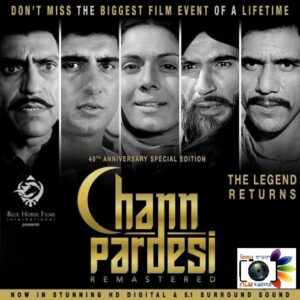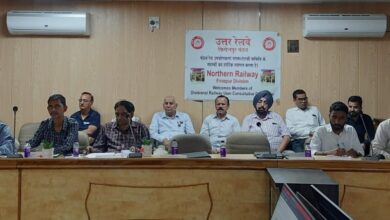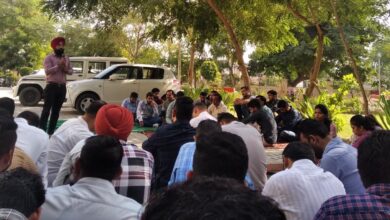Ferozepur News
From 35 M.M. to Cinemascope: Digitally Remastered Chann Pardesi by Dr. Khushminder Kaur

From 35 M.M. to Cinemascope: Digitally Remastered Chann Pardesi
Chann Pardesi, which has won the National Film Award for making a mark in the world of Punjabi cinema, is now going to release again after 40 years. The print of the film, which was first released on July 10, 1981, has been technically remastered and replaced with 5.1 Sound (Surround Sound). At the same time, his background score has been changed along with cinemascope from 35 mm. The first producers of the film in 1980 were G.S. Cheema, Sardar Baldev Gill, Mrs. Swaran Sedha and executive producer Yograj Sedha. Sardar Chanan Singh Sidhu is the new producer of this film which will be released on 20th May in the year 2022. All the stories related to this film before and even now are witnesses of the hard work behind this film.
Forty years ago, a year before its release, the film won the National Award at the 28th National Film Awards in 1980 through a committee headed by Chairperson V. Shantaram. The producers were awarded a silver medal and Rs.15,000 and the director was awarded Rs.7500 and a silver medal. While the film was technically suitable for the cinematic needs of the time, it also met all the criteria of film aesthetics. One of the great virtues of filmmaking was that the person working for each part of the film was involved in the study of theater or filmmaking. The star cast of the film was quite large with 44 various actors including Raj Babbar, Rama Vij, Kulbhushan Kharbanda, Rajni Sharma, Om Puri, Sundar, Sushma Seth, Sunita Dheer, Meher Mittal, Amrish Puri, Joga Cheema, Mohan Baggan, Baldev Gill. Mohinder Mastana, Ravi Bhushan, Varyam Mast, Jagjit Sareen, Pran Sabharwal, Bharat Bhushan, Yograj Sedha, Gurcharan Baggan, Sundar Saroop, Harjit Sidhu, Nitu Cheema, Nachhatar Singh, Ajmer Gill, Harjinder Gill, Amrit Mann, Baby, Kuldeep Singh, Qureshi, Satwant Walia, Rana Jang Bahadur etc. were students of theater.

Apart from this, its lyricist, director and producer were also students of theater and film education. Overall this masterpiece was actually an art movie/art film whose satisfying work played a major role in making it a commercial hit. As far as the story of the film is concerned, in the cinema of forty years ago, only the characters of the moneylenders and feudal lords dominating the social system of Punjab were drawn and exposed for film stories. In such a time, establishing a hero from a Dalit family was a big challenge for the producers. This challenge was accepted by the producers and they fulfilled it well because in order to raise public awareness it is necessary to deal with the forces that are in possession of the art. Artists must unite to promote good art. According to Karl Marx, “The great artist does not present motionless objects and situations but seeks to express the direction and tendency of the process. Therefore he must have a good grasp of the form of the process. The idea is to get away from the basics of life and art. ” Well, the movie Chann Pardesi is a good example of this in which the good actors united for this movie and tried to present a different concept to the people.
The film was directed by Chitrarath Singh under whose excellent direction it became the first film to win a Silver Medal. The music of the film was composed by Surinder Kohli and the background music was composed by Uttam Singh. The script and dialogues were written by Ravinder Pipat and the eleven songs in the film were written by Waryam Mast (who is now retired from the post of Regional Director, Department of Information and Broadcasting, Government of India), Ravinder Pipat, Pawan Kumar and Harjeet Gill. The song “Roz Takdi Phiran Main Tera Raah” written by Waryam Mast was the most popular song in this film. All the songs of this film are in the minds of the people due to their style, status, and musicality which were sung by famous singers of the music world Mohammad Rafi, Asha Bhonsle, Dilraj Kaur, Anwar, Savita Suman.
Actors Rama Vij and actors Kulbhushan Kharbanda, Rana Jung Bahadur, Om Puri, and Amrish Puri made their debut in the Punjabi cinema world with this film. Interestingly, Manmohan Singh who has been honored as a cameraman and director who has made a big difference in the subject matter of Punjabi films through diasporic and Punjabi nostalgia-based subjects also completed his film course from FTII Poona through this film. He started working in cinematography. Instead, cameraman Manmohan Singh himself sang three songs for the film.
The dialogues are written by Ravinder Pipat which was filmed on Om Puri in this movie “Fattad hoja thodi khatar Hazur, Mai te samaundar pee ke vi Dakar na maraan” is still ingrained in people’s minds and Gave him a new identity in the world which later helped him to work in other Punjabi films.
The significance of the re-release of this film today is due to the fact that in the year 1981, this film was dedicated to the art of some brilliant actors, which helped the people associated with today’s filmmaking world to understand the beauty of filmmaking and Inspiration is needed. Today, forty years later, the re-release of “Chann Pardesi” is a milestone in the Punjabi film world like Hindi Film Sholey. The forty-year-old print stored in the film’s archives has been taken back to London by new producer Chanan Singh Sidhu for cinemascope. The one hundred and seventy-minute film now includes English subtitles which will make the film reach the global level. The cast of this film was unmatched in terms of acting, be it in today’s cinema or in the contemporary times of this film. This success did not come to any other movie than Chan Pardesi. Due to the love and affection it received, the film was running successfully in the cinemas of Amritsar for hundreds of weeks.
Dr. Khushminder Kaur
Punjabi Cinema Researcher
98788-89217






